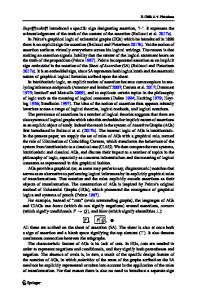Remarks on the Pre-history of the Mechanical Philosophy
The mechanical (or corpuscular philosophy) has been well-established as a historiographical category for some years now. While it certainly began as an actor’s category, it has slipped into being something else, a kind of broad catch-all category that is
- PDF / 314,580 Bytes
- 26 Pages / 439.37 x 666.14 pts Page_size
- 21 Downloads / 284 Views
The Composition of Space, Time and Matter According to Isaac Newton and John Keill Carla Rita Palmerino
5.1
Introduction
In his Mathematical Lectures, read at the University of Cambridge between 1664 and 1666, Isaac Barrow, Lucasian professor of mathematics, criticized “those who would have magnitude constituted of a finite number of indivisibles,” an opinion which he considered repugnant to the laws of mathematics. Barrow argued in favor of the infinite divisibility of all extended quantities, including material bodies: There is no part in any kind of magnitude, which is absolutely the least. Whatsoever is divided into parts, is divided into parts which are again divisible …. Though we are not able to comprehend how this indefinite division can be performed, yet we ought not therefore to doubt, but it may be performed, because we do perceive it to follow from the nature of matter, a thing most manifestly known to us.1
The young Newton, who was to become Barrow’s follower as Lucasian professor of mathematics, held a view diametrically opposed to that of his master. In the Quaestiones quaedam philosophicae, a set of notes redacted between 1664 and 1665 and contained in the Trinity College Notebook, he asserted that all extended magnitudes were composed out of a finite number of extended, but partless minima.
Research for this article was made possible through the financial support of the project Visualizing the Invisible. Representations of Matter and Motion since the Renaissance, sponsored by the Netherlands Organization for Scientific Research (NWO). I wish to thank the editors for their valuable comments on earlier drafts of this article. 1 Barrow, The Usefulness of Mathematical Learning explained and demonstrated, pp. 151, 162. C.R. Palmerino (*) Center for the History of Philosophy and Science, Radboud University Nijmegen, The Netherlands e-mail: [email protected]
D. Garber and S. Roux (eds.), The Mechanization of Natural Philosophy, Boston Studies in the Philosophy of Science 282, DOI 10.1007/978-94-007-4345-8_5, © Springer Science+Business Media B.V. 2013
117
118
C.R. Palmerino
What Newton and Barrow had in common was the fact that they applied their conclusions to “any kind of magnitude.” This choice does not need to surprise us, as it is in agreement with mainstream seventeenth-century matter theories. As I have shown elsewhere, most early modern natural philosophers believed in the isomorphism of all physical magnitudes, a belief that often led them to regard the acceleration and deceleration of bodies and the rarefaction and condensation of matter as phenomena deserving analogous treatment.2 If one looks at Newton’s later writings, however, one sees that the belief in the existence of material atoms no longer implies a belief in spatial and temporal atoms. This clearly appears in the last Query to the Optics (1704), where Newton differentiates between the properties of physical bodies, which he describes as being composed of “hard particles,” and those of space, which he asserts to be “divi
Data Loading...











